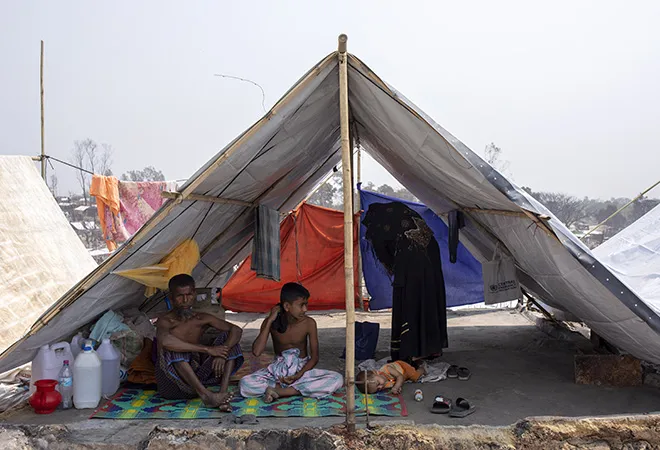-
CENTRES
Progammes & Centres
Location
The international rules-based order has failed the Rohingyas who now have spent 10 years in Myanmar detention camps.

The month of June marked a decade of suffering endured by the Rohingya population living in Rakhine state, Myanmar, from where they were evicted and are now surviving in open detention camps since 2012. The 2012 attacks on the Rohingya population unlocked an era of heightened tyranny that initiated the basis for more vicious and systematised military clampdowns in 2016 and ultimately 2017 that led to a mass exodus of close to a million hapless people to neighbouring Bangladesh. The current state of the Rohingyas living in Myanmar is worse than it was a decade back without any seemingly plausible solution.
2012 remains a dark year where sectional violence between Buddhists and Rohingyas erupted over a heinous sexual violation and murder of a Buddhist female. The Rohingya Muslims were implicated in this crime mostly through a public verdict and without any formal trial as details of the ghastly crime were disseminated locally.
The Rohingya Muslims were implicated in this crime mostly through a public verdict and without any formal trial as details of the ghastly crime were disseminated locally.
After the brutal killing of 10 Rohingyas in retaliation, a state of utter chaos descended as massacres and vandalism became rampant in the Rakhine state. Sensing that this violence has the potential to soon spread to other regions, a state of emergency was declared. This resulted in the initiation of fresh assaults on the Rohingyas who were now being accused of almost every crime. Thus, this marginalised community was dispossessed from their properties, driven out of their work, and forced to either surrender or die. While some of them escaped to neighbouring nations more than 135,000 displaced Rohingyas affected were put in 24 camps that were set up in 2012 and 2013.
The camps have resembled what the UN described as detention centres since there have been a lot of restrictions imposed regarding the movement of anyone from within the camps and outside. Checkpoints have been set every few meters. Journalists have been barred from visiting and internet cuts have disallowed information to travel outside. The camps arefenced to keep people out. The police mistreatment has been famous for curfews, threats, and bribes.
The camps are flooded with severe WASH concerns. Most of the location of the camp areas are on low-lying coastal areas. During the rainy season and annual floods, the latrine pits runoff, polluting hand pumps and wells. This results in water-borne diseases, for instance, acute diarrhoea and cholera, especially among children. There also have been decade-long deaths of children due to drowning in scarcely protected latrine pits and ponds. As of April 2022, Junta has put limitations on building or remodelling structures requiring restoration work within the camp areas. This has left 28,000 Rohingyas in unsustainable longhouses.
The people facing grave health concerns need to be shifted to the Sittwe General Hospital but cannot be accessed due to limitations of movement, restricted permissions, and financial constraints.
As per the health facilities, two healthcare centres and some casual clinics are functional within the camp areas. While they are difficult to reach by those who live in the remote corners of the camps, these centres lack professional or specialist doctors, sufficient drugs, and equipment for treatment. Furthermore, there is a lack of COVID-19 testing facilities within such clinics. There also remains no official announcement of how many displaced Rohingyas have been vaccinated to date.
The people facing grave health concerns need to be shifted to the Sittwe General Hospital but cannot be accessed due to limitations of movement, restricted permissions, and financial constraints. Those handfuls receiving treatment are placed with a security guard. At times, people are afraid to go to receive treatment outside in fear that most of them do not return alive.
The camp areas are also plagued with food insecurity. Since any form of occupation or cash benefits is restricted, these people solely rely on assistance and relief materials derived from humanitarian workers. But these workers face difficulty in operating due to restrictions on movement as there is a constant war between military forces and ethnic armed organisations. Climate and difficult terrain are some of the other difficulties that they have to face. This limits their ability to consistently provide food security to the displaced Rohingya and thus, malnutrition prevails amongst children and adults. The coup has further disrupted adequate measures to be implemented. While 56,000 IDPs in conflict areas could be provided with food support, more than hundreds and thousands are in need.
The authorities in Myanmar have been ineffective at providing any valid justification for such arbitrary confinement. Though the displaced Rohingyas have undergone decades of methodical repression and viciousness, the 2012 incident provided an opening for a long-term tactic in dealing with these people; this tactic, however, didn’t change much.
Since any form of occupation or cash benefits is restricted, these people solely rely on assistance and relief materials derived from humanitarian workers.
While it was thought that once the democratic government comes to power, the problems will dissipate, however, the complex civil-military relations have failed to address the issue appropriately.
Both the civilian and military government policies have failed to address the growing hate and Buddhist centralisation; they have not held anyone accountable for the crimes committed against these people, or encouraged secular behaviour. Thus, by not taking effective and proper actions to protect vulnerable communities, government officials themselves have become the preparators of violence and have subsequently been instrumental in further marginalising this community.
The words from international nations and organisations have also been ignored despite the pitiable situation of these people. Recently the Biden administration based on their own extensive research has declared that Myanmar’s years-long oppression of the Rohingya population is in fact a “genocide”. While the label does not indicate the formulation of new actions against the Junta but it leads to added international weight on the government, in addition to the accusations it is facing of genocide at the International Court of Justice. It’s important that the international community continues to raise its voice against the inhuman situation of the Rohingyas. Surely, decades-long imprisonment is the least they deserve.
The views expressed above belong to the author(s). ORF research and analyses now available on Telegram! Click here to access our curated content — blogs, longforms and interviews.

Sreeparna Banerjee is an Associate Fellow in the Strategic Studies Programme. Her work focuses on the geopolitical and strategic affairs concerning two Southeast Asian countries, namely ...
Read More +